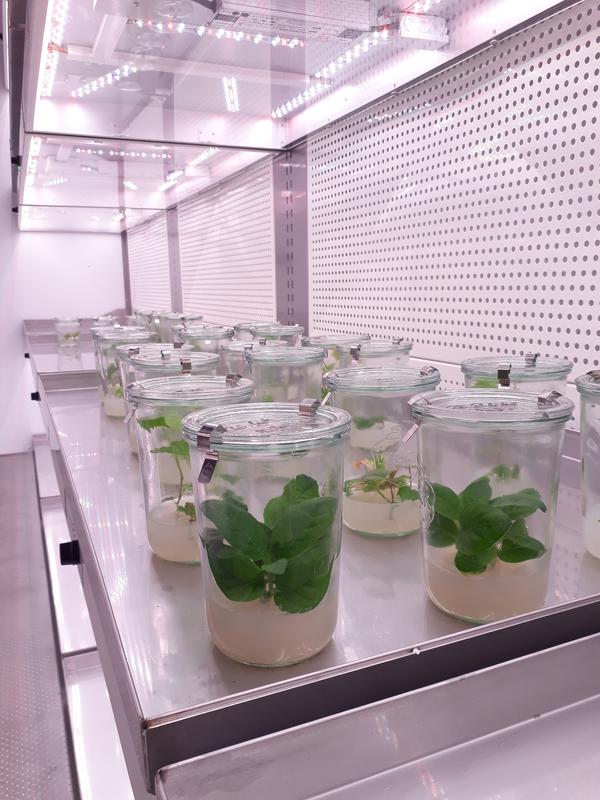Plants Emit Greenhouse Gas Nitrous Oxide at Substantial Amounts

Sterile tobacco plants in the climate chamber Photo: Steffen Greiner (Heidelberg University, COS)
Nitrous oxide, or N2O, is a greenhouse gas that affects the ozone layer and the earth‘s climate. Until now, experts believed that microbes in the soil were largely responsible for its formation. Now an interdisciplinary research team from the University of Applied Sciences Bingen and Heidelberg University have looked more closely at plants as the source. The result of the study: The earth‘s flora emits considerable amounts of nitrous oxide that contributes to the greenhouse gas effect. Unlike human-induced global warming, however, this process is part of a natural effect.
Until now, climate reports like those from the UN‘s IPCC did not include plants as a significant source of nitrous oxide in the global climate budget. Yet to accurately calculate the human contribution to the greenhouse gas effect, it is essential to identify and quantify all sources of greenhouse gases – including the natural ones. The current study shows that all the plants studied emit nitrous oxide and contribute significantly to total N2O emissions.
The researchers report that based on these studies, emissions from plants could make up roughly five to ten percent of nitrous oxide in the earth‘s atmosphere. “To truly understand the role of plants in the nitrous oxide cycle and to quantify it more precisely, further studies on representative types of plants, especially trees, are needed,” stresses Prof. Dr Katharina Lenhart.
“This study was just a first step toward quantifying plant emissions of nitrous oxide and understanding the related biochemical processes,” states the researcher, a professor of botany, limnology and ecotoxicology at the University of Applied Sciences Bingen and guest scientist at Heidelberg University.
To determine the amount of N2O emissions, the researchers studied 34 different plants under controlled conditions in a closed laboratory. Among the plants were tobacco, corn, and lavender. To avoid contamination with bacteria-generated nitrous oxide, some of the experiments were conducted under sterile conditions.
All the experiments took place in the dark so that the nitrous oxide emitted could be related to plant respiration. Like humans, plants release carbon dioxide (CO2) when they breathe. The opposite and generally better known process of CO2 absorption, however, occurs only in the presence of light during photosynthesis.
“The N2O and CO2 ratio is correlated, so we were able to use the ample existing research on plant carbon dioxide emissions to calculate the amount of nitrous oxide released,” explains Prof. Lenhart.
Isotope analyses were also carried out, because all nitrous-oxide-producing processes release a nitrous oxide molecule with a typical isotope fingerprint, including plants. “By measuring the composition of the isotopes, we were able to clearly demonstrate that most of the nitrous oxide is not released by bacteria in the soil, and that it differs from all the previously known sources,” adds Prof. Dr Frank Keppler, who directs the Biogeochemistry Research Group at Heidelberg University’s Institute of Earth Sciences.
In the next phase, the researchers will verify their laboratory results in field studies and include other plant species in their investigations. They also want to explore which biochemical process contributes to the formation of nitrous oxide in plants and the role of the biosphere in nitrous oxide formation in geological history. One particularly interesting question is how increasing global temperatures affect the rate at which plants release nitrous oxide.
Dr Steffen Greiner from the Centre for Organismal Studies (COS) of Heidelberg University also contributed to the interdisciplinary research led by Prof. Lenhart and Prof. Keppler. Other cooperation partners include researchers from the Institute for Plant Ecology at the University of Gießen, the Max Planck Institute for Biogeochemistry in Jena, the Senckenberg Natural Research Society, and the Thünen Institute of Climate-Smart Agriculture in Braunschweig. The research results were published in the journal “New Phytologist”.
Contact:
Heidelberg University
Communications and Marketing
Press Office, phone +49 6221 54-2311
presse@rektorat.uni-heidelberg.de
Prof. Dr Katharina Lenhart
University of Applied Sciences Bingen
Phone +49 6721 409-359
k.lenhart@th-bingen.de
Prof. Dr Frank Keppler
Heidelberg University
Institute of Earth Sciences
Phone +49 6221 54-6009
frank.keppler@geow.uni-heidelberg.de
K. Lenhart, T. Behrendt, S. Greiner, J. Steinkamp, R. Well, A. Giesemann & F. Keppler: Nitrous oxide effluxes from plants as a potentially important source to the atmosphere. New Phytologist (2018), https://doi.org/10.1111/nph.15455
http://www.th-bingen.de/person/katharina-lenhart/#
http://www.geow.uni-heidelberg.de/researchgroups/keppler
Media Contact
All latest news from the category: Life Sciences and Chemistry
Articles and reports from the Life Sciences and chemistry area deal with applied and basic research into modern biology, chemistry and human medicine.
Valuable information can be found on a range of life sciences fields including bacteriology, biochemistry, bionics, bioinformatics, biophysics, biotechnology, genetics, geobotany, human biology, marine biology, microbiology, molecular biology, cellular biology, zoology, bioinorganic chemistry, microchemistry and environmental chemistry.
Newest articles

NASA: Mystery of life’s handedness deepens
The mystery of why life uses molecules with specific orientations has deepened with a NASA-funded discovery that RNA — a key molecule thought to have potentially held the instructions for…

What are the effects of historic lithium mining on water quality?
Study reveals low levels of common contaminants but high levels of other elements in waters associated with an abandoned lithium mine. Lithium ore and mining waste from a historic lithium…

Quantum-inspired design boosts efficiency of heat-to-electricity conversion
Rice engineers take unconventional route to improving thermophotovoltaic systems. Researchers at Rice University have found a new way to improve a key element of thermophotovoltaic (TPV) systems, which convert heat…



